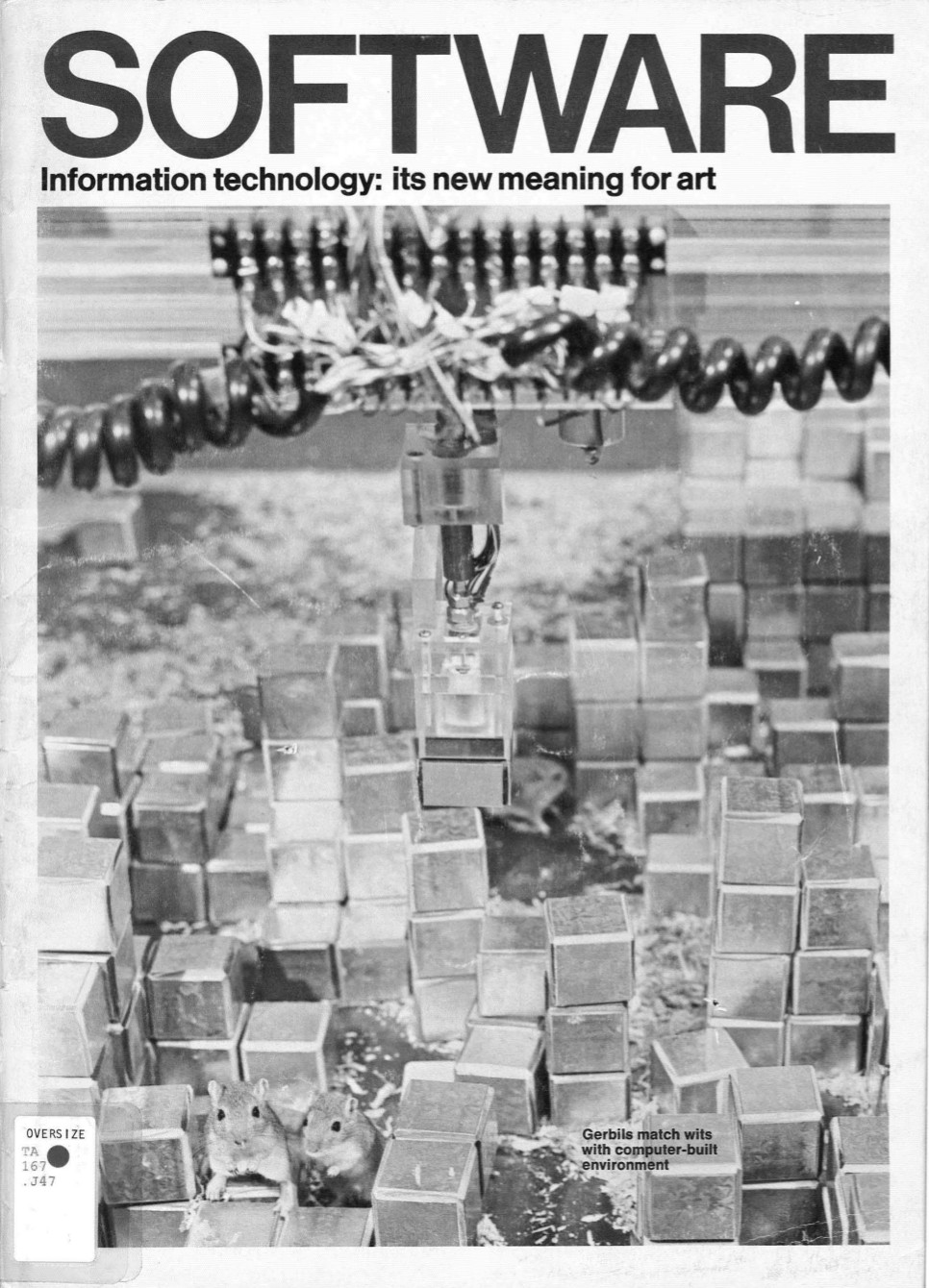Software: Information Technology: Its New Meaning for Art, catalogue (1970)
Filed under catalogue | Tags: · art, computer art, computing, conceptual art, cybernetics, machine, software, software art

Software was a show curated by an artist and critic Jack Burnham for the Jewish Museum in Brooklyn, New York City, 16 September – 8 November 1970, and the Smithsonian Institution, Washington, D.C., 16 December 1970 – 14 February 1971. The show put together computers and conceptual artists, linking them through the idea of software as a process or a program to be carried out by a machine or, why not, by the audience based on “instruction lines” formulated by the artist.
Participating artists: Vito Acconci, David Antin, Architecture Group Machine M.I.T., John Baldessari, Robert Barry, Linda Berris, Donald Burgy, Paul Conly, Agnes Denes, Robert Duncan Enzmann, Carl Fernbach-Flarsheim, John Godyear, Hans Haacke, Douglas Huebler, Joseph Kosuth, Nam June Paik, Alex Razdow, Sonia Sheridan, Evander D. Schley, Theodosius Victoria, Laurence Weiner.
Catalogue coordinator Judith Benjamin Burnham
Publisher The Jewish Museum, 1970
71 pages
via Marina Noronha <3
more about the show (Monoskop wiki)
more about Jack Burnham (Monoskop wiki)
PDF (no OCR, black&white)
Comments (2)Computational Culture, a Journal of Software Studies, Issue Two (2012)
Filed under journal | Tags: · algorithm, code, computing, law, locative media, networks, p2p, philosophy, software, software studies
Computational Culture is an online open-access peer-reviewed journal of inter-disciplinary enquiry into the nature of cultural computational objects, practices, processes and structures.
With contributions by Robert W. Gehl & Sarah Bell, Annette Vee, Bernhard Rieder, Jennifer Gabrys, Carlos Barreneche, Shintaro Miyazaki, Bernard Stiegler, Chiara Bernardi, Kevin Hamilton, “ “, Boris Ružić, Felix Stalder, Greg Elmer.
Editorial group: Matthew Fuller, Andrew Goffey, Olga Goriunova, Graham Harwood, Adrian Mackenzie
Published in September 2012
Open access
ISSN 2047-2390
A Million Random Digits with 100,000 Normal Deviates (1955/2001)
Filed under book | Tags: · computing, cryptography, mathematics, probability, randomness, statistics

“Not long after research began at RAND in 1946, the need arose for random numbers that could be used to solve problems of various kinds of experimental probability procedures. These applications, called Monte Carlo methods, required a large supply of random digits and normal deviates of high quality, and the tables presented here were produced to meet those requirements. This book was a product of RAND’s pioneering work in computing, as well a testament to the patience and persistence of researchers in the early days of RAND. The tables of random numbers in this book have become a standard reference in engineering and econometrics textbooks and have been widely used in gaming and simulations that employ Monte Carlo trials. Still the largest published source of random digits and normal deviates, the work is routinely used by statisticians, physicists, polltakers, market analysts, lottery administrators, and quality control engineers. A 2001 article in the New York Times on the value of randomness featured the original edition of the book, published in 1955 by the Free Press. The rights have since reverted to RAND, which reissued a new edition of the book in its original format, with a new foreword by Michael D. Rich, RAND’s Executive Vice President.”
Originally published by Free Press, Glencoe, Illinois, 1955
With a foreword by Michael D. Rich
Publisher Rand Corporation, 2001
ISBN 0833030477, 9780833030474
628 pages
Reviews (Amazon.com)
PDF (47 MB, updated on 2018-3-17)
PDF (a file containing the Table of Random Digits in plain text form, TXT)
PDF (a file containing the Table of Random Normal Deviates in plain text form, TXT)

